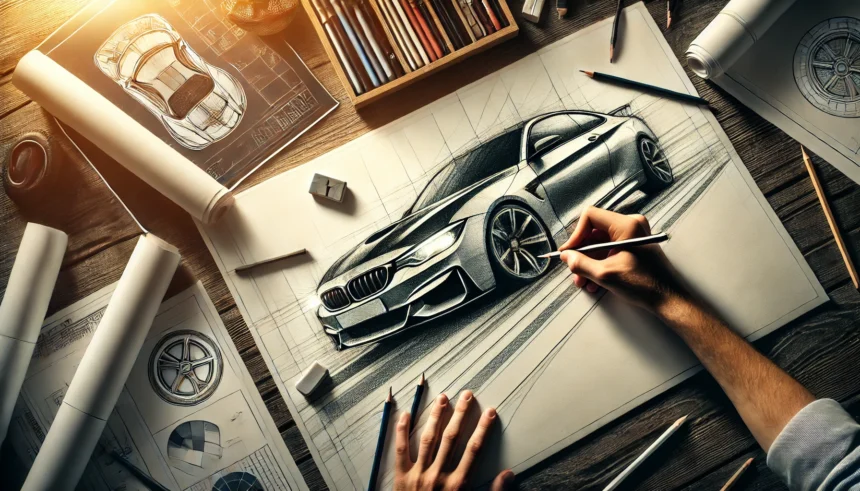Car drawing is not just a hobby; it’s a form of art that captures the essence of engineering beauty and aesthetic design combined. This art form appeals to a wide range of enthusiasts, from automotive fans to professional artists. drawing:burmhcczepe= car can be challenging but incredibly rewarding, offering an avenue to express creativity and precision. Whether you aim to sketch vintage classics or modern sports cars, the process involves understanding fundamental drawing principles and specific techniques tailored to car design.
The charm of car drawing lies in its complexity and the unique details that each vehicle presents. From the sleek curves of a Ferrari to the rugged outlines of a Jeep, every car has distinctive features that challenge an artist to delve deeper into their craft. This blog post is designed to guide you through various aspects of car drawing, from the basics of capturing shapes and proportions to advanced techniques that bring sketches to life.
Understanding Basic Car Shapes and Structures
When beginning with drawing:burmhcczepe= car, it’s essential to first grasp the fundamental shapes that construct the vehicle’s form. A car can be broken down into simpler geometric shapes that form its overall structure—rectangles form the body, circles for the wheels, and trapezoids for windows. Mastering these basic forms provides a solid foundation for adding complexity later. For those new to drawing car, starting with a side view is the easiest perspective, allowing for a clearer understanding of the car’s proportions and key features before tackling more challenging angles such as the front or three-quarter views.
Advancing from basic shapes, the next step in drawing:burmhcczepe= car involves refining these blocks into more precise outlines that resemble an actual car. This includes sharpening the rectangles into the aerodynamic body of the car, detailing the wheels with depth and tread, and accurately portraying the windows with perspective lines. This process requires patience and practice, as getting the proportions right is crucial for the drawing to look realistic. As you become more comfortable with these foundational skills in drawing car, you’ll find that adding details becomes more intuitive and enjoyable.
Tools and Materials for Car Drawing
Selecting the right tools is crucial for successfully drawing car. Beginners might start with simple graphite pencils and sketch paper, which are forgiving and easy to manipulate. However, as your skills in drawing:burmhcczepe= car progress, incorporating a variety of pencils with different hardness levels can help in adding fine details and depth to your drawings. For instance, softer pencils are excellent for shading dark areas like under the car or the tires, whereas harder pencils work well for precise lines and light details.
In addition to traditional tools, digital resources such as graphic tablets can enhance your drawing car experience by allowing for undo options and easy adjustments. Digital tools offer versatility with a wide range of brushes and textures that mimic real-life drawing instruments. They also provide the advantage of layering, which is particularly useful in complex projects like drawing:burmhcczepe= car. Whether you choose traditional or digital methods, the key is to use tools that complement your drawing style and improve your efficiency and effectiveness in bringing car sketches to life.
Techniques for Realistic Car Drawings
Achieving realism in drawing car requires a mix of technique and attention to detail. The initial step involves setting up the right perspective to ensure that all parts of the car are in proportion relative to each other. Using guidelines can help maintain the perspective throughout the drawing process. Once the basic outline is down, focus on the finer details like the headlights, grille, and wheels, which are pivotal in defining the car’s model and character in your drawing:burmhcczepe= car.
Shading plays a significant role in bringing your drawing car to life. It helps create depth, dimension, and the luster typical of car bodies. Practice different shading techniques like cross-hatching or smoothing to see what best suits the texture and finish of the vehicle you are drawing. Reflections and highlights are also critical when drawing:burmhcczepe= car, as they suggest the glossiness of the paint and the curvature of the body. Observing how light interacts with real cars can provide valuable insights into replicating these effects on paper.
Advanced Drawing Techniques
For those looking to elevate their skills in drawing:burmhcczepe= car, exploring advanced drawing techniques is the next step. Techniques such as airbrushing or adding a wash effect can be employed to create a more dynamic representation of speed and motion in your drawings. These techniques require a good understanding of light and shadow as well as a steady hand. Integrating these advanced skills into your drawing car repertoire will not only enhance the visual impact of your drawings but also expand your abilities as an artist.
Experimentation is key in advanced drawing:burmhcczepe= car. Try different materials, such as colored pencils or markers, to add a vibrant dimension to your drawings or to emphasize certain elements of the car. Each new material or technique can add a layer of complexity and uniqueness to your work, making each piece a learning opportunity and a step forward in your artistic journey.
Common Mistakes and Troubleshooting Tips
As with any skill, common mistakes are inevitable in drawing:burmhcczepe= car. One typical error is misjudging proportions, which can make a car look unnaturally stretched or compacted. To avoid this, always start your drawings with a clear guideline framework and check proportions regularly against reference images. Another frequent challenge is achieving realistic textures, such as metallic surfaces and transparent glass. It’s essential to practice different texturing techniques and understand how light interacts with these surfaces to effectively replicate them in your drawings.
Troubleshooting your drawing:burmhcczepe= car techniques is crucial for continuous improvement. If you find that your drawings often appear flat, focus on enhancing your shading skills to add more depth and volume. For issues with line work, such as shaky or uneven lines, regular practice with controlled hand movements can increase your confidence and precision. Remember, each mistake is a learning opportunity, and addressing these challenges head-on will lead to better results and a more refined drawing technique over time.
Read More: Ark: Survival Evolved (2017) Game Icons Banners
Inspiration and Resources
Finding inspiration is key to keeping your drawing:burmhcczepe= car fresh and innovative. Many artists draw inspiration from automotive magazines, car shows, or historical car exhibitions. These sources can provide a wealth of ideas on various car models, design evolutions, and technological advancements. Additionally, online platforms such as Pinterest, Instagram, and automotive blogs offer endless visual material that can spark creativity and introduce new styles or techniques to your drawing:burmhcczepe= car repertoire.
To further develop your skills, consider utilizing resources like drawing tutorials, online courses, or workshops focused on automotive art. Books about automotive design and car mechanics can also provide deeper insights into the functionality of cars, enriching your understanding and adding authenticity to your drawings. Engaging with other car drawing enthusiasts through forums or social media groups can also provide support, feedback, and motivation as you continue your artistic journey.
Conclusion
Mastering the art of drawing:burmhcczepe= car is a rewarding endeavor that combines technical skill with creative expression. By understanding the basics, experimenting with advanced techniques, and continually seeking inspiration, you can develop a unique drawing style that brings your automotive visions to life. Remember, the key to success in car drawing, as in any form of art, is practice and persistence. Each sketch you create brings you one step closer to becoming an expert in your craft.





